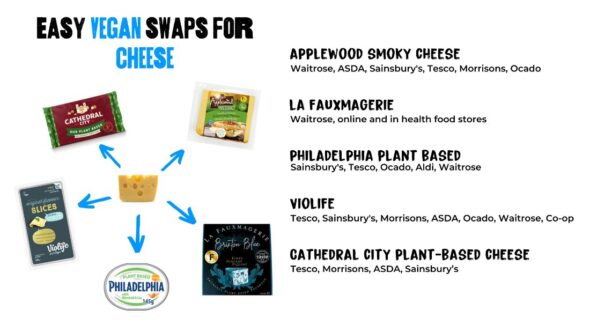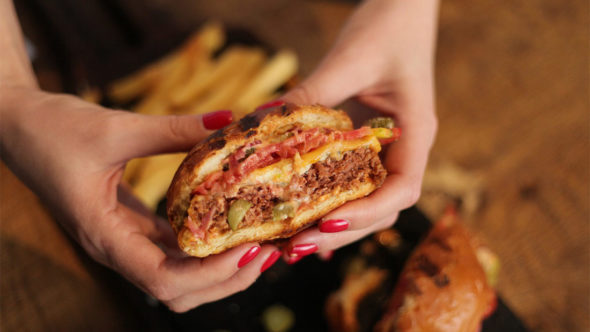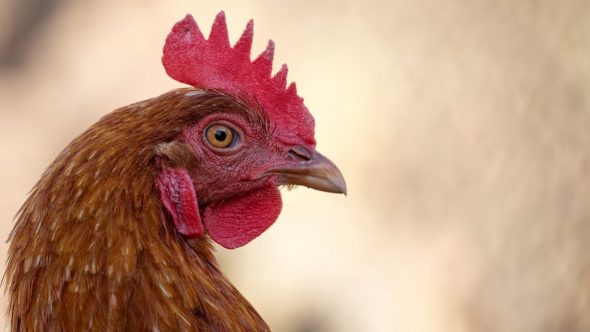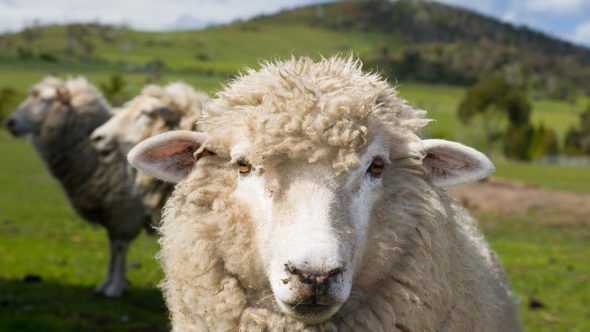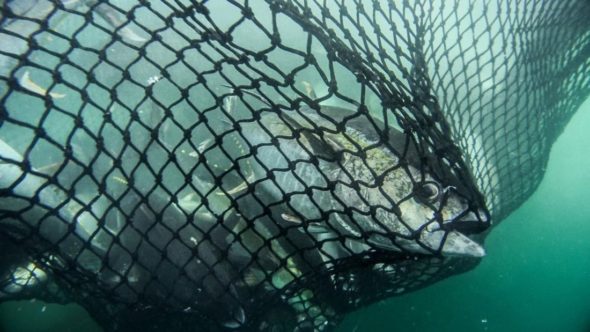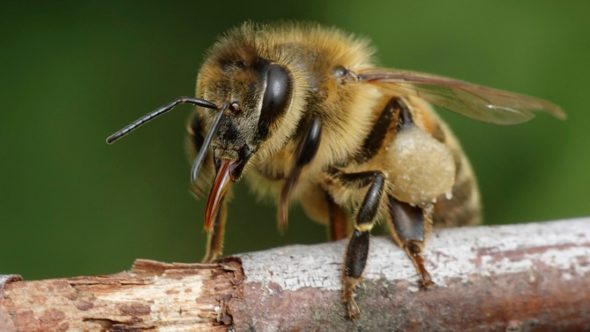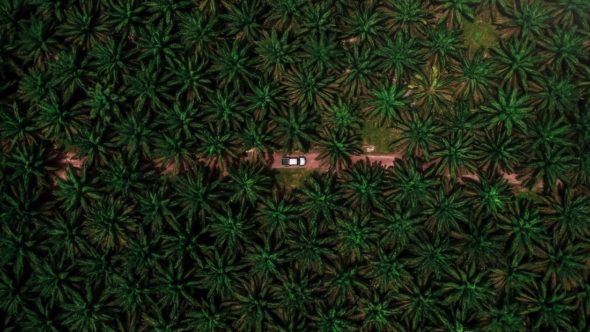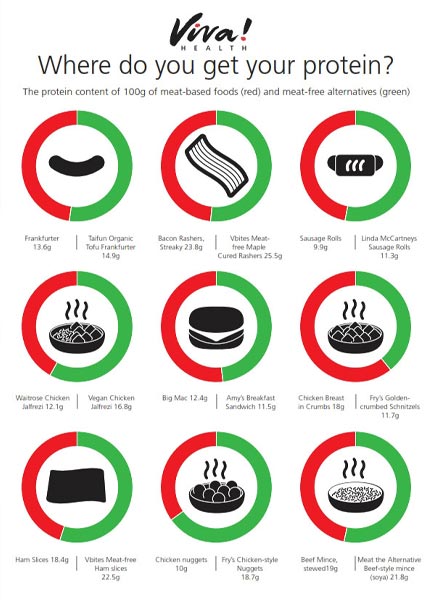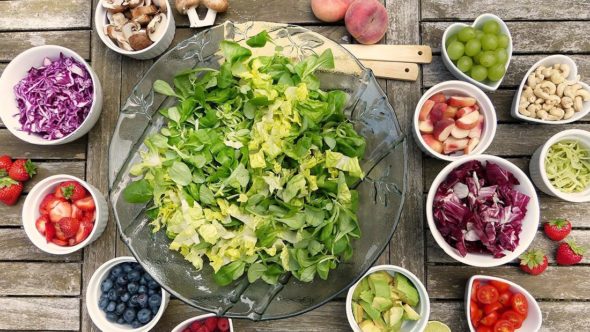Vegan FAQs
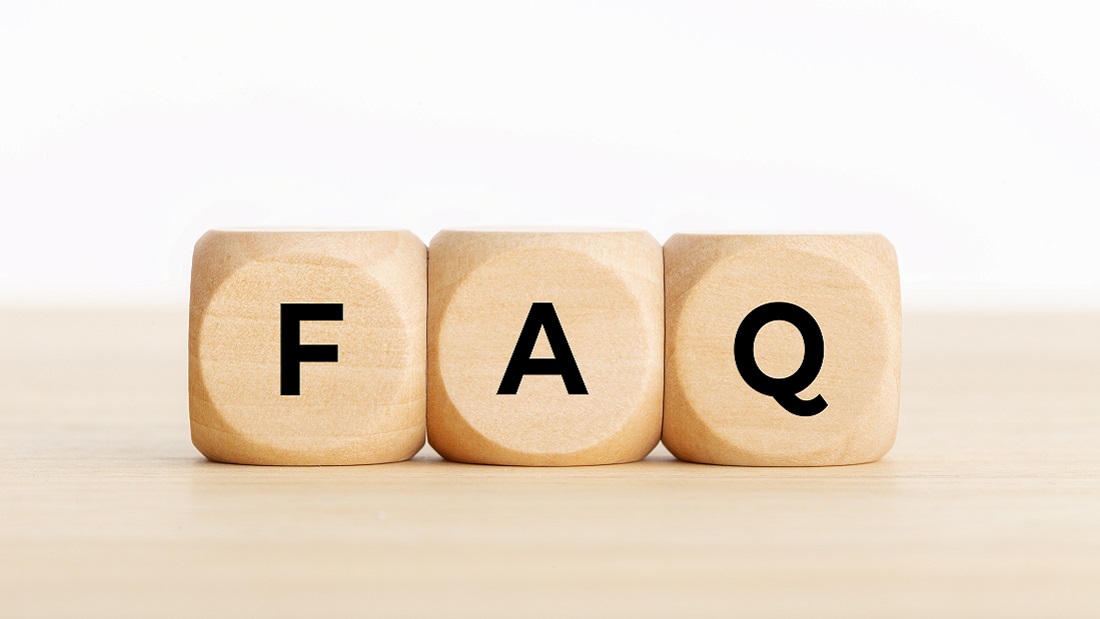
We’ve answered the most frequently asked questions about veganism. From the classic “where did you get your protein?” to the more recent “aren’t vegans destroying the rainforests?” — we have it covered! So whether you’re here to learn about veganism in general, to answer a specific question, or to find a good rebuttal to a social media comment, we’re sure you’ll find the answer here.
Veganism is expensive
There seems to be a common misconception that vegan diets are expensive or at least more expensive when compared to animal products. This isn’t the case! The idea that vegan diets are expensive seems to come from ready meals, processed foods and from restaurant menus – some of which have been known to overprice vegan options. However, a vegan diet which is based on fresh fruit and vegetables, beans, pulses, cereals and grains, can be much cheaper than relying on animal products such as cheese or meat. The staples of a healthy vegan diet are some of the most affordable foods you can find, including tinned legumes, grains, pasta and potatoes. Check out our favourite budget recipes here.
Veganism is too difficult and restrictive
This is another misconception about veganism. Long gone are the days of limited menu choices and only being able to find chips and salad! Nowadays, you can find dairy-free products, vegan cheese, and meat alternatives in nearly every supermarket. You can also find vegan options in tons of mainstream pubs and restaurants, such as Pizza Express, Frankie & Benny’s, Zizzi’s, Wagamama, Las Iguanas, Subway, and even Wetherspoons. You can also find sandwiches, drinks and snacks in mainstream coffee shops like Pret, Starbucks, Caffe Nero and Costa. This means you can still socialise with friends and family whilst eating vegan.
In terms of veganism being difficult, there’s a popular technique to help with going vegan called ‘crowding’. It means rather than completely cutting out animal products all at once, you keep seeking out and trying new vegan dishes. When you find something you love, you save this product/recipe and incorporate it into your weekly dishes. Eventually you’ll replace all the animal products with new and delicious foods, instead of cutting out and restricting your diet. You’ll soon find that any of your current favourite dishes can also be made vegan!
My partner and / or family doesn’t want me to go vegan
When you go vegan, you are choosing to change a fundamental part of your life. You are going against societal norms and a ‘carnistic’ culture which teaches us that meat is ‘normal, natural and necessary’. This means you are also potentially changing the dynamic with your friends and family, as so much of human relationships and socialisation are based around food sharing. This is normal and the good news is, it will most likely be temporary.
Although some families or friends might not initially seem supportive of a vegan lifestyle, there are lots of great ways to address this and over time most people come to understand and accept these positive changes (sometimes inspiring others to make amazing changes too!).
We would recommend reading Dr Melanie Joy’s guidance on this, but some small changes you can make to help improve your relationships are:
- Find opportunities to share food where possible. There are loads of ‘accidentally vegan’ foods and recipes, meaning you can find common ground with your partner/family.
- Avoid discussing veganism around the dinner table. This is possibly one of the worst times to talk about it, as you will end up making your partner/family feel defensive and shamed while they are eating. Shame is one of the strongest human emotions and it will make their barriers go up. It’s best to have a peaceful mealtime, where everyone feels relaxed and respected, and then to discuss veganism away from the table. If you are not the one to start the discussion during dinner, perhaps politely explain you would rather talk about this afterwards and make sure to set aside some time later on.
- Praise the small steps. If your partner chooses a vegan option or picks you up some dairy-free ice-cream, let them know how much you appreciate it.
- Educate yourself. By going vegan, you are unwittingly becoming an ambassador for veganism and so do your best to prepare responses to the most common arguments — like the ones on this page! If you don’t know something, it’s better to say you’re not sure but you will find the information out, maybe you could even research it together?
- Let the results speak for themselves! When you go vegan, you’ll likely find that you feel healthier, have more energy, become more passionate about food and just feel better in general. Your partner/family will see these changes in you and — if they have your best interests at heart — will be happy for you.
- Let them come to you. In our experience, it’s much better to allow people to ask questions about veganism rather than bring it up yourself. It can even be a small question about your food, or it might be asking why you’ve gone vegan. This shows that the person is ready to talk about it and may be much more receptive to your reasoning.
- Have patience. Most likely, it took you weeks, months, years to make the decision to go vegan. Try to understand that your friends and family aren’t at that stage yet, but it doesn’t mean they won’t ever be.
- It’s all about tone! You can say almost anything you like, so long as the tone is right! And humour works really well. But get the tone wrong – angry or defensive – the person you’re trying to influence will switch off, or worst away!
The key message here is not to force veganism upon anyone. Instead, lead by example with delicious foods, a positive attitude and a healthier lifestyle. You’ll soon find that your partner/family are much more receptive and open to veganism.
What difference will one person make?
A huge difference. The average British meat eater consumes, in the course of their lifetime, 5 cattle, 20 pigs, 29 sheep and lambs, 780 chickens, 46 turkeys, 18 ducks, 7 rabbits, 1, geese and half-a-tonne of fish. So by going vegan you’re saving a lot of lives. Just as importantly, the best advertisement for veganism is a healthy and happy vegan: if you turn vegan you will be able to influence others to become part of the movement towards a more compassionate and rational world.
Plants feel pain!
This question is usually seen as a bit of a joke, but if you want a serious answer here goes! Plants do not feel pain. They do not have pain receptors, nerves or a central nervous system. They have evolved without the ability to flee from pain – so it would make no sense to feel it! And even if plants did feel pain, the average meat eater is responsible for about 10 times more plants being killed than the average vegan because all the animals that meat-eaters consume, eat huge amounts of plants themselves.
I can’t give up cheese
Don’t worry, we totally understand! Cheese addiction is real and once you break free from it, the cravings stop.
Cheese contains an extremely high concentration of the milk protein casein that, when digested, results in casomorphins. Casomorphins are opioids, belonging to the same chemical family as morphine and opium, inducing euphoric feelings and lowering pain. This is nature’s ingenious way to help bond mother and baby (in nature, animals don’t drink milk past weaning, so being addicted to cheese or any dairy isn’t a problem!).
Casomorphins are addictive and if you suddenly stop eating cheese, you might experience uncomfortable withdrawal symptoms and strong cravings.
Of course a huge part of our cheese cravings is also due to the fact that cheese is high in fat and salt, which is the magical combination that humans respond to with voracious appetite. Think crisps, chips, bacon, everything cheesy, salted nuts and fried savoury foods (basically all junk food). This is because for a long time in humankind’s history, food wasn’t always abundant, so our bodies evolved to recognise fatty foods as good energy sources and developed a taste for them. Even though most of us now have more than enough food on a daily basis, our bodies still crave fats and cheese is a prime example of it backfiring.
So what should you do?
- If you can’t go cold turkey don’t worry, just try weaning yourself off slowly and pick a few days where you’ll go without cheese. Increase these days over a period of time and eventually you’ll be happily cheese-free!
- Try adding nutritional yeast to your food. It gives a lovely, cheesy, nutty flavour and can be sprinkled over soups, salads, pasta, pizza, asparagus… pretty much anything (one of the Viva! team eats it straight from the tub!).
- You don’t have to switch immediately to vegan cheese. Although vegan cheese now has incredible flavours and textures and there’s an amazing selection out there that you’ll almost certainly grow to love, it isn’t the same as cow’s milk cheese so it can take time to adjust to new tastes. It might be worth having a period without any cheese for a few months. You can actually retrain your brain to like certain tastes by eating them more frequently.
- Try making your own nut-based cheeses: this can be lots of fun and the flavours are great!
- Try some delicious cheese-free recipes from our site.
So there you have it! If you stay away from cheese for a few weeks, one day you’ll realise the desperate craving’s gone. If it’s the naughty salty fat taste you’re after in the meantime, go for chips or crisps (within reason!), olives or anything with a strong flavour.
But bacon though!
This comment barely warrants a response, but here goes! Like cheese, bacon is loaded with fat and salt, the magical combination that humans respond to with voracious appetite. Think crisps, chips, bacon, everything cheesy, salted nuts and fried savoury foods (basically all junk food). This is because for a long time in humankind’s history, food wasn’t always abundant, so our bodies evolved to recognise fatty foods as good energy sources and developed a taste for them.
The troubling truth is that bacon is terrible for piggies and for you!
- A large-scale study from Harvard School of Public Health reported how red meat consumption is associated with an increased risk of early death. One serving of processed meat (one hot dog or two slices of bacon) a day was associated with:
- 20 per cent increased risk of early death
- 21 per cent increased risk of death from cardiovascular disease
- 16 per cent increased risk of death from cancer
- Harvard conducted more research in 2012 and found that a daily serving of bacon (two slices) was associated with a two-fold higher risk of diabetes.
- The International Agency for Research on Cancer (IARC), which is part of the The World Health Organization has declared that eating just 50g of processed meat (less than two slices of bacon) a day increases the risk of bowel cancer by 18 per cent. They also classified consumption of processed meat as “carcinogenic to humans”.
- Another study by Larsson et al (2006) looked at the effect of bacon and found that people eating the most bacon have a 37 per cent higher risk of stomach cancer than those eating the least.
- Processed meats such bacon also have a higher content of saturated fats and cholesterol than red meat. Both high saturated fat and cholesterol intake are related to the risk of heart disease.
Worse still, bacon comes from pigs kept in atrocious conditions. They are killed at six months old for bacon – and they don’t want to die.
So, instead of dreaming about bacon, you should instead be considering the various cancers, diabetes, heart disease you can get from eating bacon. And the animal suffering it causes. Ask yourself — are my cravings for bacon worth a pig’s and your early death?
I don’t mind you being vegan – but you shouldn’t try to impose your views on other people. It’s a matter of individual choice.
Trying to persuade people to change their minds is not “imposing your views” upon them. It is the kind of healthy disagreement which democracy depends on and which is essential for positive change to take place.
What we eat is also not simply a matter for individuals. Meat-eating and veganism are not two sides of the same coin: one brings death and suffering to animals, damages the planet and harms human health and the other does the opposite. The reason that vegans try to change the minds of non-vegans is because their “individual choice” affects countless other beings, human and non-human. And, more often than not, it is non-vegans who start these arguments and not the other way round!
Didn’t we evolve to eat meat?
No we didn’t. Science shows that humans have many more characteristics in common with herbivores than carnivores. Humans are great apes, not lions or wolves! Our guts are longer, so we can digest lots of plant materials, whereas carnivores have shorter guts to allow meat to pass through them quickly. We are not suited to eating raw meat, bones and tendons and cooked meat, even at moderate levels, is associated with a wide range of health problems, including heart disease, diabetes and cancer. Even during hunter-gatherer times, humans would have only eaten meat on the rare occasion they successfully hunted and would mainly sustain themselves on plants, nuts and berries. Meat doesn’t contain any nutrients that we cannot get from healthier plant-based foods.
Are our teeth designed to eat meat?
The idea that we are ‘designed’ to eat meat is flawed on many levels. Our teeth are not designed to slice and tear flesh. Our mouths (we can’t open them wide enough!) and teeth are the wrong shape to be able to kill and hold captive struggling prey. We have strong molars made for grinding fruit and vegetables. Carnivores have extremely sharp canine teeth (and sharp claws!) which are designed for tearing flesh. Compare your own teeth to a lion, or even your cat or dog, to see that we are not made to be carnivores. This explains why humans must cook meat before eating it and why we’re no good at crunching and munching uncooked bones.
But what about gorillas? They’re almost vegan and have huge canine teeth. That’s because their teeth are actually used for dominance displays and warn off other male gorillas, not for eating meat.
Eating meat is natural
As we’ve just seen, it isn’t. Humans have only eaten meat in relatively recent evolutionary history and then only through the use of tools like spears and fire. Only when we started farming (hardly natural!) did meat become even a regular part of most human beings’ diets.
Additionally, eating meat on a daily basis is very recent – since the advent of factory farming after the Second World War. This brought the cost of rearing animals down and the meat eating explosion was the result. In 1946, for example, the number of poultry eaten in Britain was 31.9 million and in 2001 it was over 800 million. And what’s natural about factory farming, live exports and slaughterhouses?
Why do you care about animals and not people?
Compassion towards animals is not in competition with compassion towards people. Veganism also helps us!. The meat and dairy industries cause environmental degradation through deforestation, soil erosion, water pollution and the production of greenhouse gases – we would live in a cleaner, better world if we were all vegan.
Secondly, because meat production is such an inefficient way of producing food it consumes resources which should go to people. In the developing world, land is increasingly being devoted to the production of animal fodder for export to the rich world instead of being used to grow food for the local population.
Finally, veganism improves human health, which brings rewards for individuals and also to society as a whole which needs to spend less on health care and lost working days through ill health. There are also increasingly more slaughterhouse workers speaking out about poor working conditions, low wages, workplace injuries and long-term PTSD.
Veganism is a human rights issue!
If we all went vegan, wouldn’t we be overrun with animals?
Farmed animals are forcibly impregnated; they are not allowed to reproduce naturally. As demand for meat and dairy goes down over time, so will the number of animals being bred. That means we will not be overrun with millions of farmed animals, but their numbers will slowly dwindle. Eventually, the few that are left can be allowed to go free: pigs can root around in woodlands as it is natural for them to do, sheep will graze the hillsides like deer and so on. Their populations will find their own natural levels, just like every other animal.
If we all went vegan, all the animals would die out
The converse of the above question! It’s true that the number of animals will fall as farmers breed fewer and fewer animals as the years go by. Farmed animals live a controlled, distorted life, often filled with pain and fear. The vast majority of farmed animals are kept in indoor units where they never see the light of day. Those that are kept outside are only kept alive for a fraction of their natural lifespans before being slaughtered for meat – often in the most barbaric manner imaginable. All farmed animals are born to die at our command – a disgusting idea. Also some breeds have been so changed from their natural ancestor that it would be kinder to let them die out. For example, broiler chickens and turkeys bred for meat are often so obese that they can barely walk and suffer from crippling leg disorders. However we could set up large nature reserves for the more traditional (now rare) breeds that haven’t been so changed.
There would be much more land available for reserves because most of it is used to grow crops for fattening animals at present. Also, there would be more space for forests and woods and other wildlife reservations where genuinely wild British species of animal and plants could flourish. In other countries we could encourage the breeding of farmed animal’s wild ancestors – the wild pig, turkeys and jungle fowl (the forerunner of the egg laying breeds in factory farms) by stopping the destruction of their homes.
Many people forget that all farmed animals have been bred from wild animals – and that their natural ancestors need preserving.
In a vegan world animals would not be kept for profit and greed but would be allowed to exist in their natural state and live their life in freedom.
Other animals kill for food: why shouldn’t we?
Animals do lots of things we don’t do and wouldn’t do! The key difference here is that we have a choice. Lions, tigers, and other carnivores have to kill to survive. We don’t. We can — and need to — think about the consequences of our actions. If we can avoid inflicting suffering on another being, if we can meet our own needs whilst benefiting the planet, if we can live happily and healthily on a vegan diet — shouldn’t we? Can industrialised animal farming really be compared to an animal acting on instinct?
Don’t cows need to be milked?
One of the public’s biggest misconceptions of dairy production is why cows produce milk. Many are still unaware that in order to produce milk, a cow first needs to be pregnant, just like humans, and to give birth every year in order to meet the demands of modern, high-yield dairy farming. Cows do not just produce milk, it is milk intended for a baby calf.
Just like us, cows must have a baby to produce milk. Cows are extremely protective and caring of their offspring. In nature, they give birth in private and hide the calf in long grass out of sight for about a week before introducing the newborn to the rest of the herd
Despite having strong maternal instincts, in all modern dairy farming (whether indoor or free range/organic) calves are removed from their mothers shortly after birth. Cows grieve as a result. The male calves are often shot as a useless by-product or are killed later for cheap beef and the female calves go on to replace their mothers in the milking herd — forcibly impregnated and milked until they die of exhaustion.
Chickens lay eggs anyway, what’s wrong with that?
Yes, chickens lay unfertilised eggs. But there’s nothing natural about modern egg production. In the wild, hens would only lay 10 to 15 eggs in a whole year, but humans have selectively bred chickens to lay increasingly more. On modern-day farms hens are subjected to near constant lighting and fed high protein feed to increase egg production so they produce over 300 eggs a year. This is far more than their bodies can handle.
But that’s not the only thing that’s wrong with egg production. Cruel practices such as break trimming (without anaesthetic) is routine on egg farms, regardless of whether the eggs are caged, organic or free-range. This is to prevent the hens pecking each other, a behaviour exacerbated by the poor environmental conditions. The hens are killed for cheap meat as soon as their productivity falls at about 18 months old. They would naturally live until about 8 years. Like male calves, male chicks are useless to the industry and are killed shortly after birth.
You might be wondering why hens lay unfertilised eggs at all? That’s because the egg is mainly developed while unfertilised. The hen doesn’t know in advance whether the egg will be fertilised, so grows the egg in the hope that it will be. In the wild, this works well because most eggs are fertilised. But humans have exploited this phenomenon and pushed hens to the limit, all so we can eat their eggs. Is it worth it?
Don’t sheep need to be sheared?
Selective breeding has ensured that sheep have fleeces that cannot be shed naturally over the summer months, leaving them at risk of heat exhaustion. (Sheep on animal sanctuaries are sheared but not under time pressure and with care.) Shearing typically takes place once a year, at the beginning of the summer. Shearing may also occur just before the sheep are housed for the winter (although this is rare in the UK); this is because wool is likely to be of better quality than summer wool as sheep have not recently been through the stresses of lambing and lactation.
Sheep have best friends; they like (and dislike!) particular members of their flock and often form bonds which last a lifetime
A professional shearer is able to shear one sheep in less than two minutes, which works out at 250 sheep in one day. Shearers are commonly paid per animal rather than by the hour; this means that shearers spend as little time as possible on each animal and consequently welfare is often compromised. It is common for sheep to suffer nicks from the shearers used in the process. To prevent the sheep becoming ill from stress during shearing, food and water are often withheld for eight hours. The restraints and close contact with the shearer also make the sheep stressed and scared.
Some lambs are sheared for the first time at approximately seven months old and their wool is sold at higher prices because it is softer than wool from an adult sheep.
Once the wool is sheared it is graded. Low and high quality wool will have different end uses; low quality fibre will be used for carpets and high quality soft wool can be used for delicate clothing. Then the wool is washed and dried to remove the grease (lanolin). Lanolin is often used in cosmetics. The wool is then combed, spun and weaved to become wool fabric.
The kindest thing would be not to keep breeding sheep for wool and meat.
Fish can’t feel pain
Numerous scientific studies have confirmed that fish do feel pain. Industrial fishing causes them immense suffering because they are killed either by being crushed in the net, having their swim bladders explode when they are brought to the surface or by asphyxiating (being starved of oxygen) on the decks of trawlers. Many fish, especially salmon, are also now intensively farmed and suffer from infectious illnesses, parasites and overcrowding.
Several types of fish cooperate when they hunt. One interesting example is the grouper and the eel, who use signals and gestures to communicate their desires or intentions and help each other catch prey.
Additionally, overfishing is causing immense damage to the world’s largest and most delicate ecosystems – our oceans. Up to 90 per cent of fish populations have been depleted from the oceans, with bottom-sea trawlers decimating everything in their path. And this level of destruction isn’t even just for our food. Almost 70 percent of wild fish that are made into non-food products is used to feed farmed fish and livestock, with each tonne of farmed salmon eating three tonnes of wild-caught fish – clearly, this is not sustainable.
What’s the problem with keeping bees for honey? Don’t we need to increase the bee population?
Producing honey is hard work: a bee makes just a twelfth of a teaspoon in her lifetime. Female foraging worker bees collect nectar from flowers. When she finds a good source she returns to the hive and tells the others where it is by doing a ‘waggle dance’ positioning the flower in relation to the sun and the hive. Nectar is transferred to hive bees who ingest and regurgitate it from their ‘honey stomach’ repeatedly adding enzymes to break down the sugar (sucrose) in it into fructose and glucose. Another enzyme uses glucose to make hydrogen peroxide, which makes honey acidic. The bees ingest and regurgitate the honey until it is partially digested. So honey is actually bee vomit! It is left to dry in the honeycomb then sealed in with beeswax as a food supply for the winter. All this work only for humans to come along and steal it, replacing it with syrup made from white sugar and water – not really a fair swap! Saying it might be ‘ethical’ for small scale bee keepers to take a small amount of honey is like saying it’s OK for a shoplifter to only take a couple of items! Leave them alone and use maple or agave syrup instead.
As to increasing bee populations – to do this we need to plant bee-friendly plants; to rewild land decimated by animal agriculture and to reduce the use of pesticides, most of which are used on monocultures grown for animal fodder..
It’s okay to eat animals if they lived a good life and are killed humanely
Would it be alright to kill and eat people if they’d had a good life? And who are we to choose when another being is killed or to decide whether their life has been good enough? These are nothing more than excuses used to justify killing animals, to ease the feeling of guilt because on some level — you know it is wrong to kill.
What defines a ‘good life’? Where do you draw the line in suffering?
Animals, of course, want to live just as much as we do. The first instinct every animal has is to survive. By killing them at all, we are taking away from them the most important thing they have; we are denying their intrinsic right to life. It is all so unnecessary when we can be happy and healthy on a vegan diet.
But I only eat organic and free-range meat, dairy and eggs anyway.
It is naive to think the organic and free-range animal products are free from suffering. For example, even on ‘free-range’ egg farms, thousands of hens can be kept in a shed with limited access to the outside. Even in the better free-range or organic egg farms, all male chicks are killed within hours – useless by-products as they do not lay eggs and are too scrawny for meat.
Although free-range and organic animals ‘may’ lead better lives than factory-farmed animals, they still suffer in many ways. All farms prevent animals from living natural lives and all are sent for slaughter as soon as there is more profit in killing them than in keeping them alive.
All animals kept for farming are prevented from mixing in normal social groups, and ducks never see their ducklings; hens their chicks; pigs have their piglets taken away much too young; dairy cows have their calves ripped from them at one day old. Even on free range farms the male calves are shot as they don’t give milk and are the wrong breed for beef. All farms prevent animals from living natural lives. And all are sent for slaughter as soon as there is more profit in killing them than in keeping them alive.
It is also not sustainable to only have organic and free-range meat. We simply do not have the land or resources. So then you find yourself back to intensive factory farming which causes immense suffering. Ultimately, the only truly consistent and ethical choice is to eat no meat, dairy or eggs at all.
Why do vegans keep some animals as pets but disagree with the use of animals in all other areas?
Offering a forever home to a companion animal is not the same as buying a ‘pet’ from a commercial breeder. Vegans support the homing of rescued animals from shelters and so on but do not regard them as commodities. Overcrowding in rescue centres is an all too common problem created by humans, it’s really up to us to try and resolve it and adopting an animal is the kindest solution.
Should you make your cat or dog go vegan?
The nutritional needs of dogs and cats can easily be met with a balanced vegan diet and certain supplements.
Dogs have evolved over the last 10,000 years to and are regarded as omnivores that can thrive on a plant-based diet. However, you must ensure their diet is balanced and contains all the nutrients they need. Dogs are not wolves – they have adapted to being human companions and have genes for the enzymes amylase and maltose that help them digest carbohydrates/starches – wolves don’t have these. Also a dog’s gut microbiome is quite different to that of wolves, they have bacteria that can also break down carbohydrates and to some degree make amino acids (the building blocks of protein) normally sourced from meat.
The nutritional requirements for cats are a little more complicated as they are classified as ‘obligate carnivores’. However, some vegan cat food producers add supplements to their vegan food providing cats with nutrients otherwise only found in meat. Specially formulated diets made up of plant, mineral and synthetically-based ingredients can meet their nutritional needs. This is no more ‘unnatural’ than feeding a cat Bluefin tuna or beef!
Some people wonder if it’s unnatural to omit meat from the diets of dogs and cats. But to feed them the meat that they would naturally eat, you would have to serve them whole mice or birds not ground up leftovers of factory-farmed animals.
Andrew Knight, professor of Animal Welfare and Ethics at the University of Winchester says: “Diseases demonstrated to be more likely following long-term maintenance of cats and dogs on some commercial meat-based diets include kidney, liver, heart, thyroid, neurologic, neuromuscular, skin, and infectious diseases, and bleeding disorders”.
So conventional commercial pet food is doing them no favours. Supplemented vegan food is the healthiest option for cats, dogs and the planet!
What would happen to the countryside if we stopped animals grazing on it?
We would need to use less of our countryside for agriculture if we were all vegan – that means that more of it could return to a natural state. Britain has less woodland than any other northern European country – we could change that if we didn’t need to use land to grow crops for animal feed.
Far from being a loss to the countryside as some people imagine, ending livestock farming would mean a huge toll of suffering would be eliminated and wildlife allowed to recover. Globally, if everyone went vegan 76% less land would be needed for agriculture! There would be much more land available for reserves and sanctuaries because most of it is used to grow crops for animal feed at present. Also, there would be more space for forests and woods and other wildlife reservations where genuinely wild British animals and plants could flourish.
Isn’t soya destroying the planet?
Yes, rainforests are being destroyed at the rate of three football fields a minute and thousands of animals (and people) are left without shelter or food in order to grow soya. But the soya isn’t to feed people.
Currently, almost 70 per cent of the soya grown in South America is fed to livestock, and 90 per cent of the Amazon’s destruction is to grow more animal feed (i.e. soya) or for cattle grazing.
This is a hugely inefficient way of farming. If we cut out the middle man — i.e. gave soya crops directly to people instead of animals — we would have more than enough food to feed everyone and, in turn, would need less land to grow food. Vegan soya foods sold in the UK are not from areas that grow rainforests and are non-GMO.
Aren’t almonds causing drought?
Almonds are not the biggest problem with water use in agriculture. Livestock farming uses up a quarter of the world’s freshwater supply. Much of this precious water is used to grow crops for animal feed. Almonds are much more efficient water-users per calorie than dairy or beef for example.
Vegans are destroying the planet by eating avocados.
The argument against vegans eating avocados is based on the fact that bees are needed to pollinate them and in some areas like California in the US, there are not enough local bees for the pollination of the massive fruit, vegetable and nut-farms so bees are transported in. There are many smaller farms that rely on natural bee populations and in an ideal world, we should try and buy from them as much as possible. According to the New Agriculturalist and the American Beekeeping Federation, beans, tomatoes, apples, broccoli, melons, carrots, onions and hundreds of other fruits, vegetables and grains are also pollinated by bees bred for commercial purposes. As vegans, we just do our absolute best according to what’s practical and possible. This is a bit like the ‘figs are not vegan’ story based on how female fig wasps can become trapped and die in figs when laying their eggs in them – part of the natural pollination process. Almonds, avocados and figs remain a lot more vegan than beef burgers and milkshakes – and don’t forget – all these farmed animals are fed plant foods too! Not to mention, non-vegans also eat avocados.
It is impossible to be 100% pure – but we can live a life that minimises suffering and exploitation whenever possible – any step towards doing this is better than no step!
What about quinoa and the fact that Peruvian people can’t afford to eat it now?
This is a myth based on false allegations that Peruvian farmers who grow quinoa could no longer afford to buy the expensive food due to vegans pushing the price up. A study published by the International Trade Centre (ITC), the joint agency of the UN and World Trade Organisation based in Geneva shows that the opposite is the case in Peru: high quinoa prices in fact improved the welfare of poor rural communities. As prices rose between 2004 and 2013, quinoa farmers (who are among the poorest people in Peru), saw a 46 per cent increase in their welfare.
However, trade has resulted in a reduction of diversity of quinoa production into just 20 or so varieties. In the altiplano (high plateau regions in the Andes of Argentina, Bolivia and Peru), subsistence farmers have cultivated up to 60 different varieties, which in future may offer a way to adapt to climate change. Creating new consumer demand for these traditional varieties is one way to help conservation of traditional varieties.
Do you think it’s possible for all countries to go vegan? Even poorer countries who rely on fishing and other small subsistence farms?
Feeding food that humans could eat to animals, so that humans can eat them instead, is clearly a waste of precious resources: over a third of the calories from global crops are currently used for animal feed but only 12 per cent of those feed calories find their way into the human diet as meat and other animal foods – the rest is wasted. If everyone went vegan and food was grown solely for humans (without feeding it through farmed animals), we could increase available calories by as much as 70 per cent, which could feed an additional four billion people – more than the projected two or three billion predicted in population growth by 2050. Less land would be required and land not suitable for arable crops could revert to forest and scrubland.
If the world went vegan, we could feed an additional four billion people.
Farmers would be unemployed if we stopped eating meat.
People will still need to eat when we are all vegan, so there will still be plenty of jobs for farmers! In fact the intensive farming of animals has caused severe unemployment in agriculture as so few people are employed to look after so many animals. A vegan world would mean more people employed in sustainable methods of farming and there is increasingly more support for farmers wishing to switch from animal farming to arable farming.
Want to know more? Read Jay Wilde’s story, a beef and dairy farmer who went vegan and gave his cows to an animal sanctuary. The Vegan Society also supports farmers transitioning to arable farming with their Grow Green scheme.
Why do so many vegan products contain palm oil? Do vegans eat palm oil?
It’s not that so many ‘vegan’ products contain palm oil, it’s that so many ‘products’ contain it! Palm oil is big business – found in around half of all items on supermarket shelves from pizza dough to lipstick. The main organisation responsible for the certification of sustainable palm oil is the Roundtable on Sustainable Palm Oil (RSPO), made up of producers, processors and traders, manufacturers, retailers, investors and NGOs. In response to consumer pressure, in 2018 they introduced a new standard prohibiting member companies from clearing any type of forest for oil palm plantations. This has been welcomed with cautious optimism as there are concerns about enforcement. It’s a personal choice and you have the power to vote with your wallet.
Is it healthy to be a vegan?
A healthy vegan diet is one consisting mainly of fruit and vegetables, pulses, wholegrains, nuts and seeds. It is low in saturated fat and free from animal protein, cholesterol and hormones – all linked to disease. A vegan diet can provide all the nutrients required for all stages of life, including pregnancy, lactation, infancy, childhood, adolescence and for athletes too!
Head on over to Viva! Health for more information. In particular, you may find the A-Z of Nutrients useful.
But where do you get your protein?
Years of advertising and marketing of products with high protein content have created the myth that we constantly need to be looking for more and better sources of protein but nothing could be further from the truth.
Most people in Western societies have the opposite problem – far too much protein – and protein deficiency is almost unheard of. If you eat a healthy and varied vegan diet that provides enough calories, protein won’t be on your worry list!
On average, men should eat 55 grams and women 45 grams of protein daily. The best plant sources of protein include pulses (lentils, beans, chickpeas,peas and soya), nuts, seeds and whole grains (wholemeal bread,wholewheat pasta and brown rice). One large serving of cooked tofu could provide up to half the protein you need in one day!
I’m worried that I will lack amino acids on a vegan diet
A good, vegan diet can adequately provide all the amino acids our body needs. Amino acids are the building blocks of protein required for growth and repair of all body cells and they come in two varieties – essential and non-essential. For an adult, there are nine essential amino acids which have to be included in the diet as our bodies are incapable of making them and 12 other non-essential ones – those made in the body.
Protein is found in all plant foods and good sources include nuts, seeds, grains and legumes – peas, all types of beans and lentils, etc.
Simply eating a normal variety of foods throughout the day guarantees that all amino acids are provided. There is no need to combine different plant proteins at each meal as the body has an amino acid ‘pool’ which collects all the different types. Having said that, combining tends to happen naturally with meals such as beans on toast. Beans are a rich source of the amino acid lysine but not so rich in methionine. Bread – like most cereals – is rich in methionine but not so rich in lysine. And that’s how it works.
Will I become anaemic if I stop eating meat?
No, you should be able to get all the iron you need from a vegan diet. Iron is an essential part of the oxygen-carrying molecules haemoglobin and myoglobin. Haemoglobin is found in red blood cells and myoglobin is found in muscles. Iron also makes up part of many proteins in the body.
The amount of iron you need is 8 milligrams a day for men over 18, 14 milligrams a day for women aged 19-50 years, 8.7 milligrams a day for women over 50
You should be able to get all the iron you need from your daily diet. The best plant sources of iron include whole grains (quinoa, wholemeal spaghetti and wholemeal bread), fortified breakfast cereals, pulses (lentils, tempeh – fermented soya beans, tofu, baked beans, kidney beans, peas), seeds (pumpkin seeds, sesame seeds and tahini – sesame seed paste), dried fruit (apricots and figs), seaweed (nori) and dark green leafy vegetables (kale). Vitamin C helps the absorption of iron from foods so it’s good to combine iron and vitamin C-containing foods in one meal.
Women have higher requirements as they lose iron during menstruation. Those who lose a lot of blood during menstruation (heavy periods) are at higher risk of iron deficiency anaemia and may need to take iron supplements. This applies to all women, not just vegans!
Will I need to supplement calcium if I don’t eat dairy?
No, a healthy vegan diet containing the foods listed below on a daily basis will cover your needs.
We associate calcium with bones and rightly so. But calcium has other functions too – it’s important for muscle function, nerve transmission, signalling within cells and hormone formation. Calcium is a building block for bones and they contain 99 per cent of the total calcium in your body. But calcium can only build bones properly if your body has enough vitamin D. So even if you eat plenty of calcium, it could go to waste if you don’t get enough vitamin D.
Adults need 700 milligrams of calcium per day. The best plant sources of calcium are: tofu (made with calcium sulphate), fortified vegan breakfast cereal (eg Ready Brek), plant-based milk alternatives fortified with calcium, dried figs, kale, sesame seeds and tahini (sesame seed paste used in hummus), tempeh (fermented soya beans), wholemeal bread, baked beans, butternut squash, almonds and Brazil nuts, spring greens and watercress.
Do I have to take supplements as a vegan?
You need to either take a B12 supplement or make sure you include B12-fortified foods like soya milk in your diet every day. B12 deficiency is not uncommon in the population, regardless of diet, and in the US, everyone over 50 is advised to take a supplement as absorption declines with age. Everything else, you should be able to get from a varied vegan diet. Of course everyone in the UK is advised to consider taking a vitamin D supplement in the winter due to lack of sunlight and we all need to keep an eye on our omega-3 fats, iodine and zinc but this applies to everyone regardless of diet.
What is B12 and where can I get it from?
B12 is made by bacteria in soil and water and to some extent bacteria in the gut (although production in the gut occurs in a different area to where absorption takes place). Traditionally, people, as well as farmed animals, got B12 from eating food from the ground. However, now food production systems are so sanitised, we need to take a supplement. Animal products contain vitamin B12 because the animals are given this vitamin in their feed too. Around 80 per cent of global production of B12 is in France and over a half of that is used to supplement animal feed. This makes the recommendation to eat animal products to obtain B12 somewhat invalid. Cut out the middleman and get B12 straight from the source or include B12-fortified foods in your diet such as soya milk and nutritional yeast.
Whether you choose fortified foods or supplements, you need to consume these regularly. There’s no need to take extra high doses but if you do have a high-dose supplement, taking up to 2,000 micrograms a day of vitamin B12 is unlikely to cause any harm.
The best plant sources of vitamin B12 include yeast extract (Marmite/Vegemite), nutritional yeast flakes with B12, B12-fortified plant-based milks, B12-fortified plant-based yoghurts and desserts, B12-fortified breakfast cereals and B12-fortified margarine. Make sure the ones you buy are fortified with B12.
What is iodine and where can I get it from?
Adults need 140 micrograms of iodine per day. Most people should be able to get all the iodine they need by eating a varied and balanced diet. Seaweed is a good source – sprinkle a little in soups and stews but don’t overdo it – excess iodine can disrupt thyroid function leading to weight gain, hypothyroidism or hyperthyroidism. The Department of Health advise that intakes of up to 500 micrograms a day of iodine are unlikely to cause harm (tread carefully with kelp – it can contain very high levels).
Do I need to eat oily fish to get Omega-3?
No, definitely not! Plants can provide all the healthy types of polyunsaturated fat that we need. Rich sources of essential fatty acids – also known as omega-3 and omega-6 fats – include seeds, nuts, legumes – including the oils made from them – and green, leafy vegetables. Omega-6 fats are widely distributed in plant and manufactured foods and most people get more than enough. Omega-3 fats aren’t so common but there are ample plant sources that are exceptionally rich in them. These include flaxseed, rapeseed oil and walnuts.
When you eat omega-3 fats they are converted by the body into what are called long-chain fatty acids – principally EPA and DHA – and they play a major role in the development and functioning of the brain, nervous system and cell membranes. They also help regulate blood pressure and are involved in the body’s immune and inflammatory responses. Obtaining omega-3 from plants and letting the body do the conversion means that the resulting EPA and DHA is fresher than that found, ready-made in oily fish such as salmon and sardines. Oily fish, of course, obtain their pre-formed EPA/DHA from plant sources – algae!
We need about 100-300mg of EPA each day and one tablespoon of linseed oil – of which 50 per cent is omega-3 fat – supplies approximately 200mg, the same as one large capsule of fish oil. A handful of mixed, unsalted nuts and seeds each day – walnuts, brazils, hazelnuts, almonds, linseeds, sunflower and sesame seeds – can also do the trick. Linseed oil makes a good dressing for salads and other cold foods but isn’t suitable for cooking as heat destroys the beneficial fats. A healthy alternative is olive oil.
I’ve heard that soya is bad for you and high in oestrogen. Is this true?
There are a lot of myths still flying around about soya and tofu which is such a shame as it’s an amazing food for lots of reasons. Here are some of the most common ones:
Myth 1: Soya isn’t healthy
Soya is a great source of protein, containing all nine essential amino acids and providing more protein than most other pulses. It’s also a source of ‘good fats’ (omega-3 and 6), antioxidants, calcium, B vitamins and iron. It lowers cholesterol and reduces the risk of certain cancers and other diseases.
Myth 2: Soya messes with men’s hormones
Be reassured – the man-boob jokes are nonsense! Soya contains phytoestrogens, natural substances also found in many fruits, vegetables, beans, peas and wholegrains. Their chemical structure is similar, but not identical, to the oestrogen found in animals, including humans. However, they are 100 to 100,000 times weaker and therefore have very little oestrogenic effect, if any. Studies on humans concur that phytoestrogens from soya foods are completely safe. In fact, men may even benefit from eating more as studies suggest that soya consumption is linked to a lower risk of prostate cancer. And don’t forget, cow’s milk and dairy products contain actual oestrogen!
Myth 3: Vegans are destroying the rainforest
Around three-quarters of soya worldwide is used for animal feed – for cows, pigs and chickens – so that people can eat meat, dairy and eggs. Most of it comes from the Amazon and other places facing environmental destruction, with only around six per cent of global soya production being eaten by humans.
Many of the soya foods consumed in the UK are made with organic beans sourced from Europe and the US, unlike the genetically-modified types grown for animal feed. If you want to see less destruction of the rainforest, switch to a vegan diet and eat MORE soya!
God put animals on earth for us to eat
No major religion states that people must eat animals. Many devout Christians, Muslims, Buddhists and Jews are vegetarian, as are all Hare Krishnas and Jains as well as several million Hindus. For most religious people the question remains one of individual judgement. Compassion, kindness and mercy are encouraged in all religions. Modern-day factory farms and slaughterhouses do not seem consistent with that.
Isn’t religious slaughter of animals humane?
Some Halal (Muslim) and all Shechita (Jewish) slaughter is performed without stunning the animal. The animal is bled to death by having his or her throat cut while fully conscious.
Although, Shechita and Halal slaughter is intended to minimise the suffering of the animals, such as a focus on using a very sharp blade in both religions to kill the animal quickly, the animal will still suffer. The kindest action we can do by animals is not to kill them, either through stunning means or not. There is no compassionate way to take the life of an animal who does not want to die.
Neither Islam nor Judaism mandates that we must eat animals, and many people of all faiths see that the treatment of animals, both in how they are reared and how they are killed, causes unjustifiable suffering.
Many meat-eaters point to Shechita and Halal slaughter as inhumane. It is but then so is mainstream slaughter – which often goes wrong. Also, whether the animal is stunned or not, he or she still suffers from the transportation to the slaughterhouse in cramped lorries, the terrifying experience of being herded into an abattoir, and is killed at a fraction of his or her natural life expectancy.
It is not a question of whether religious slaughter is better or worse than stunned slaughter. Both practices cause immense suffering to animals. Religions all around the world advocate kindness to humans and other animals. Choosing vegan is the most merciful action we can take.




